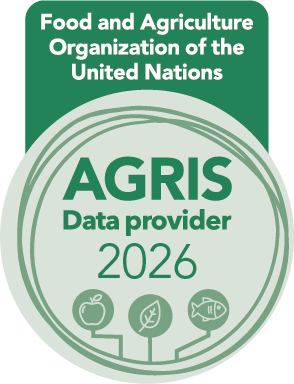Phenotypic characterization and diversity analysis of single-type tuberose(Agave amica syn. Polianthes tuberosa)
DOI:
https://doi.org/10.24154/jhs.v20i1.4029Keywords:
Cluster analysis, evaluation, principal component analysis, tuberoseAbstract
Tuberose is a popular ornamental crop valued for its attractive, fragrant white flowers, which are extensively used as cut and loose flowers, and for extraction of essential oil. The present study was conducted to evaluate the morphological variability among 14 single-type tuberose varieties based on 27 quantitative traits. Among the evaluated genotypes, the variety Arka Prajwal exhibited superior performance in several floral and vegetative traits such as number of leaves (38.43), leaf length (53.61 cm), leaf width (2.40 cm), plant spread (N–S: 99.57 cm; E–W: 99.20 cm), weight of single floret (2.18 g), floret diameter (6.41 cm), floret weight per spike (115.78 g), flower yield (11.58 t/ha), and bulb diameter (3.71 cm). The variety Bidhan Snigdha excelled in traits like rachis length (44.43 cm), floret length (7.36 cm), floret width (5.10 cm), bulb weight per clump (310.23 g), bulblet weight per clump (210.69 g), individual bulb weight (51.84 g), and bulb length (7.22 cm). The varieties Prajwal, Bidhan Snigdha, and GKTC-4 were identified as high loose flower yielders and are recommended for commercial cultivation. Principal component analysis (PCA) revealed that the first six components (Eigen value >1.0) accounted for 90.48% of the total variation, with PC1 and PC2 contributing 47.97% and 14.42%, respectively. Cluster analysis using Ward’s method supported the PCA results, grouping the genotypes into two major clusters based on morphological traits. This study provides valuable insights for tuberose breeding, varietal improvement, and germplasm conservation programs.
Downloads
References
Benschop, M. (1993). Polianthes. In A. De Hertogh & M. Le Nard (Eds.), The physiology of flower bulbs (pp. 589–601). Elsevier, Amsterdam, the Netherlands.
Bhargav, V., Kumar, R., Bharathi, T. U., Dhananjaya, M. V., & Rao, T. M. (2023). Assessment of genetic diversity in China aster [Callistephus chinensis (L.) Nees]. Journal of Horticultural Sciences, 18(1), 84–89. https://doi.org/10.24154/jhs.v18i1.2138
Chaturvedi, A., Mishra, T. S., Kumar, N., & Singh, S. S. (2014). Screening of different cultivars of tuberose (Polianthes tuberosa L.) under agro-climatic condition of Allahabad. Progressive Horticulture, 46(1), 146–148.
Dogra, S., Pandey, R. K., Laishram, N., & Singh, A. (2020). Varietal evaluation of tuberose under agro-climatic conditions of Jammu. Pharma Innovation Journal, 9(2), 499–501.
Gandhi, D. P., & Bharathi, T. U. (2021). Genetic variability and diversity study in tuberose (Polianthes tuberosa L.). International Journal of Chemical Studies, 9(3), 235–240.
Gupta, N. K., Rakesh, K. S., & Mahobla, R. (2004). Performance of tuberose (Polianthes tuberosa L.) cultivars and their vase life in Malwa region of Madhya Pradesh. National Symposium on Recent Trends and Future Strategies in Ornamental Horticulture, Dharwad, India, 19.
JMP. (2022). JMP® 17.1.0: Statistical analysis software system. SAS Institute, Cary, NC, USA.
Kavitha, R., & Anburani, A. (2009). Genetic diversity in African marigold (Tagetes erecta L.) genotypes. Journal of Ornamental Horticulture, 12(3), 198–201.
Mahawer, L. N., Bairwa, H. L., & Shukla, A. K. (2013). Field performance of tuberose cultivar for growth, floral and economic characters under sub-humid southern plains and Aravalli hills of Rajasthan. Indian Journal of Horticulture, 70(3), 411–416.
Mahovia, R. (2003). Studies on the performance of different tuberose (Polianthes tuberosa Linn) cultivars and their vase life (M.Sc. thesis). Jawaharlal Nehru Krishi Vishwa Vidyalaya, Jabalpur, Madhya Pradesh, India.
Naik, B., Kamble, B. S., Tirakannanavar, S., & Parit, S. (2018). Evaluation of different genotypes of tuberose (Polianthes tuberosa L.) for growth, flowering and yield characters. International Journal of Current Microbiology and Applied Sciences, 7(7), 4135–4141. https://doi.org/10.20546/ijcmas.2018.707.482
Panse, V. C., & Sukhatme, P. V. (1985). Statistical methods for agricultural workers (pp. 1–35). ICAR Publication, New Delhi, India.
Ramachandrudu, K., & Thangam, M. (2008). Performance of gladiolus varieties under agro-climatic conditions of Goa. Journal of Ornamental Horticulture, 11(2), 91–97.
Ramachandrudu, K., & Thangam, M. (2009). Performance of tuberose (Polianthes tuberosa L.) cultivars in Goa. Journal of Horticultural Sciences, 4(1), 76–77.
Reddy, D. M., Momin, K. C., Bhargav, V., Kumar, S., Singh, A., & Phurailatpam, A. (2024). Morphological characterization of Dendrobium orchid species of East Siang district of Arunachal Pradesh. Journal of Horticultural Sciences, 19(2). https://doi.org/10.24154/jhs.v19i2.1621
Sadhu, M. K., & Bose, T. K. (1973). Tuberose for artistic garlands. Indian Horticulture, 18(3), 17–20.
Sheena, N., Beniwal, B. S., Dalal, R. P. S., & Shiwani. (2019). Studies on the effect of nitrogen and phosphorus on flowering and spike yield of tuberose (Polianthes tuberosa L.) cv. Prajwal. Journal of Pharmacognosy and Phytochemistry, Special Issue 1, 109–112.
Singh, A. K., Sisodia, A., & Padh, M. (2018). Performance of tuberose varieties for flowering and flower yield parameters under Indo-Gangetic plains of eastern Uttar Pradesh, India. International Journal of Current Microbiology and Applied Sciences, 7(8), 1129–1133. https://doi.org/10.20546/ijcmas.2018.708.128
Singh, K. P. (1995). Improved production technologies for tuberose (Polianthes tuberosa L.): A review of research done in India. Indian Institute of Horticultural Research, Hessarghatta, Bangalore, India. (CAB Abstract, 1996–1998/07).
Downloads
Published
Data Availability Statement
Raw data available upon request from the corresponding author.
Issue
Section
License
Copyright (c) 2025 Pushpanjali Bhosale, V V Bhagat, Naveen Kumar Prathapani, Tarak Nath Saha, Ganesh B Kadam, Prashant Kawar, Narendra Gajbhiye, D Mahesh Reddy (Author)

This work is licensed under a Creative Commons Attribution-NonCommercial-ShareAlike 4.0 International License.
Authors retain copyright. Articles published are made available as open access articles, distributed under the terms of the Creative Commons Attribution-NonCommercial-ShareAlike 4.0 International License, which permits unrestricted non-commercial use, distribution, and reproduction in any medium, provided the original author and source are credited. 
This journal permits and encourages authors to share their submitted versions (preprints), accepted versions (postprints) and/or published versions (publisher versions) freely under the CC BY-NC-SA 4.0 license while providing bibliographic details that credit, if applicable.







 .
. 











